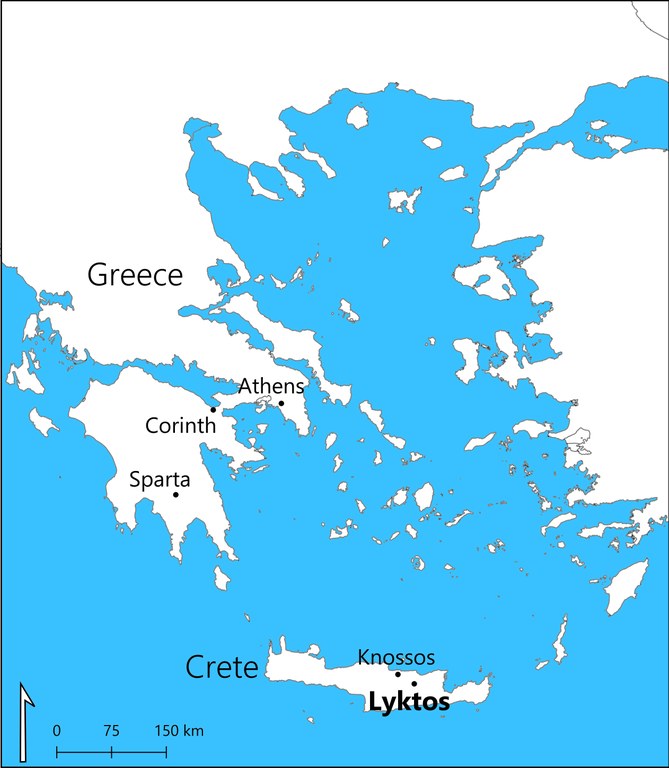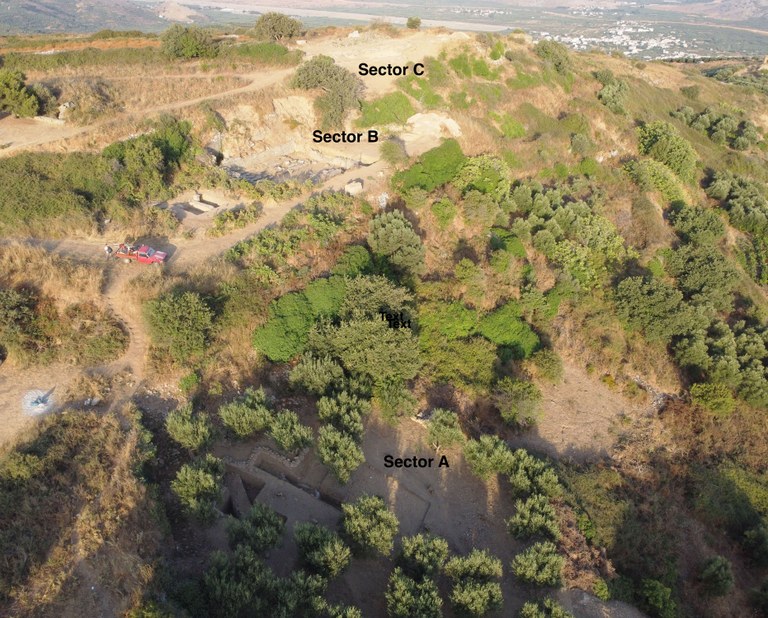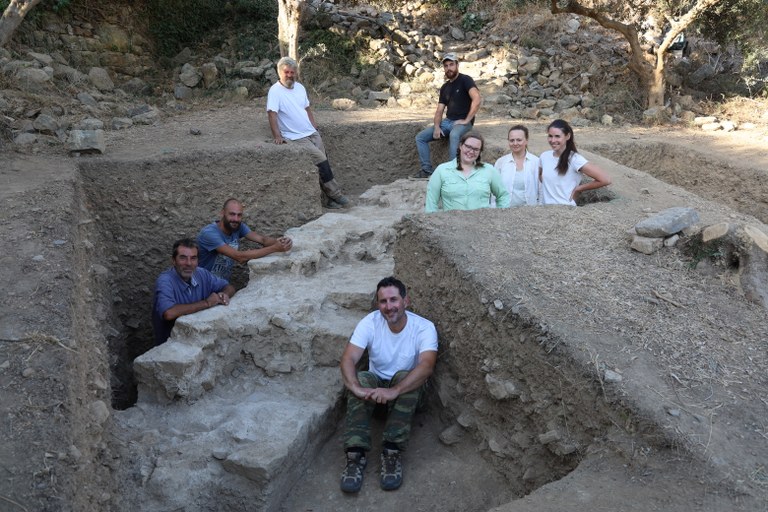Faculty Focus: Antonis Kotsonas
 Map of Greece, showing the location of Lyktos on Crete. Created by Christina Stefanou.
In July 2021, an ISAW team became involved in a new fieldwork project at Lyktos, on the island of Crete, Greece. Lyktos, one of the most powerful Cretan cities in the Greek and Roman periods, is located inland. The site occupies a tall and long hill, rising to 620 a.s.l., and is flanked by high mountains (to the east) and a vast plain (to the west), where the new international airport of Crete is currently being constructed.
Map of Greece, showing the location of Lyktos on Crete. Created by Christina Stefanou.
In July 2021, an ISAW team became involved in a new fieldwork project at Lyktos, on the island of Crete, Greece. Lyktos, one of the most powerful Cretan cities in the Greek and Roman periods, is located inland. The site occupies a tall and long hill, rising to 620 a.s.l., and is flanked by high mountains (to the east) and a vast plain (to the west), where the new international airport of Crete is currently being constructed.
Celebrated by Homer, and considered as the birthplace of Zeus by the early poet Hesiod, Lyktos boasts an unusually rich literary and epigraphic record from Classical antiquity. Aristotle and other authors held that Lyktos was a colony of Sparta and deliberated the extent to which the Cretan city was the source of the famed Spartan constitution. Lyktos was an arch rival of Knossos for several centuries, and the stealthy attack and dramatic sack of the city by the Knossians in 220 BCE captivated the ancient historian Polybius. Lyktos was quickly resettled, and by the Roman imperial period it was a major exporter of wine to Central Italy, and it attracted the sponsorship of emperors, especially Trajan and Hadrian in the 2nd century AD. In Early Christian times the city was the seat of a bishop but declined and was abandoned during the Medieval period. The site has since remained largely unaffected by building activity and the surrounding landscape is basically pristine.
Notwithstanding the rich textual record for Lyktos, and the interest of many renowned archaeologists in excavating it, the site has attracted very limited and only small-scale fieldwork. The newly established Lyktos Archaeological Project (LAP) is co-directed by ISAW’s Antonis Kotsonas and Angelos Chaniotis, from the Institute for Advanced Study at Princeton. The project involves the collaboration of Vasiliki Sythiakaki, from the Greek Archaeological Service, is run under the auspices of the Archaeological Society at Athens, and encompasses both fieldwork and the study of archaeological material previously unearthed at Lyktos. Given the challenges posed by the pandemic, the project team was small this year and involved specialist collaborators (including the former ISAW Visiting Research Scholar Cicek Beeby), graduate students from ISAW (Georgios Tsolakis and Christina Stefanou), graduate students from other institutions in North America and Europe, and undergraduate students from the University of Crete.
 The acropolis of Lyktos with the three excavation sectors marked. The plain in the backgroundis occupied by the town of Kastelli and the runway of the military airport which is being turned into the new international airport of Crete. © Lyktos Archaeological Project.
Ancient Lyktos was vast in size (100 hectares by a certain estimate), but our fieldwork targeted areas by the hilltop, where previous research and visible remains posed intriguing research questions regarding different periods of ancient history.
The acropolis of Lyktos with the three excavation sectors marked. The plain in the backgroundis occupied by the town of Kastelli and the runway of the military airport which is being turned into the new international airport of Crete. © Lyktos Archaeological Project.
Ancient Lyktos was vast in size (100 hectares by a certain estimate), but our fieldwork targeted areas by the hilltop, where previous research and visible remains posed intriguing research questions regarding different periods of ancient history.
Sector A, located on the upper north slope of the hill, was the main focus of the team led by Antonis Kotsonas. The area yielded rich evidence for the earlier history of Lyktos, including material which dates from around 1000 BCE, when the city was allegedly founded, and from the 8th and 7th centuries BCE, when Homer and Hesiod praised Lyktos. Richer finds date from the 6th to 4th centuries, a period which is poorly researched in Crete. These finds establish that Lyktos prospered at the time and imported fine – including pictorial – pottery from Athens, Corinth and Sparta for use in feasting activities, perhaps including the local syssitia (the ritualized dinning of men from Lyktos) described by ancient authors. The finds were located around two structures, one of which is monumental in size. These structures were exposed only partially this summer, but they are instrumental to our interpretation of activity in the area and will be explored further next year.
 Members of the excavation team posing around the monumental wall discovered in Sector A. © Lyktos Archaeological Project.
In Sector B, Angelos Chaniotis explored the surroundings of a Roman public building excavated in the 1980s and interpreted as a bouleuterion (or council house). The new fieldwork established that the building was more monumental and richly adorned than previously assumed, and involved several more rooms. This work also yielded evidence for imperial statuary, including an over-life-size marble statue of a Roman emperor of the 2nd century CE.
Members of the excavation team posing around the monumental wall discovered in Sector A. © Lyktos Archaeological Project.
In Sector B, Angelos Chaniotis explored the surroundings of a Roman public building excavated in the 1980s and interpreted as a bouleuterion (or council house). The new fieldwork established that the building was more monumental and richly adorned than previously assumed, and involved several more rooms. This work also yielded evidence for imperial statuary, including an over-life-size marble statue of a Roman emperor of the 2nd century CE.
In Sector C, which occupies the highest point on the acropolis of Lyktos, Vasiliki Sythiakaki revealed part of a large Early Christian Basilica. The monument probably dates from the Byzantine Dark Ages, and given its location, and its size and decorative elaboration, it is tentatively considered as the seat of the local bishop.
LAP is scheduled to continue for four more excavation seasons. Future ISAW newsletters will provide further reports on our fieldwork and discoveries, and their importance for the history and archaeology of Greece and the Mediterranean.